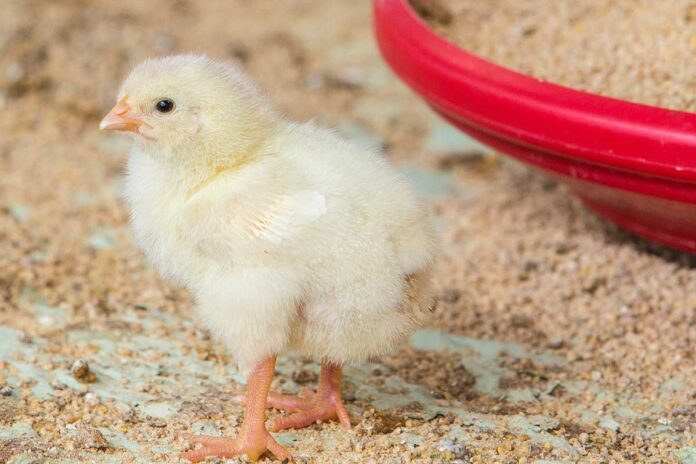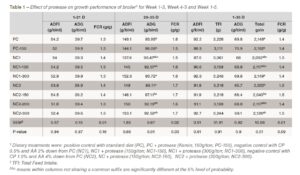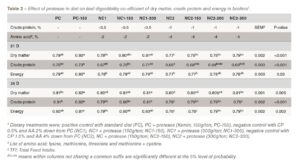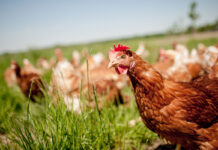
The present study investigates the effect of protease on the productivity of broilers under reduced crude protein (CP) and amino acid (AA) diet conditions.
A total of 504 one-day-old Ross 308 broilers were allocated into nine treatments with eight replicates per treatment. Basal diets 1-3 weeks and 4-5 weeks included; positive control (PC), negative control one (NC1) with 0.5% lower CP and 2% lower AA and negative control two (NC2) with 1.0% lower CP and 4% lower AA compared to PC diets. Amino acids reduced in NC1 and NC2 diets were dig Lys, dig M+C and dig Thr compared to PC. These basal diets were used to create six more treatments by adding protease on top. Protease was included at 150g/ton and 300g/ton for NC1 and at 150g/ton, 200g/ton and 300g/ton of protease for NC2 diets. All treatment diets were provided ad-libitum in a mash form.
Production performance, carcass traits, carcass composition and production indices were analyzed at 21 and 35 days. Data were analyzed using one-way ANOVA in SPSS. Results showed that the supplementation of protease (P<0.05) improved the daily gain and breast meat yield in positive and negative control groups. In conclusion, the results indicated that the supplementation of protease into the reduced CP and AA diets can improve the growth performance of broilers.
Soybean meal (SBM) is the primary protein source in broiler diets
Although SBM is highly digestible, it contains glycinin, protease inhibitors, and antigenic proteins that are indigestible and can cause intestinal damage and impair immune functions resulting in suboptimal growth performance. With the development of commercially available protease, protein and amino digestibility is greatly improved allowing the control of anti-nutritional factors in SBM and enables the use of alternative protein sources in formulations. This leads to lower formula cost and better growth performance. Reduction of nitrogen emissions in livestock production is also a growing concern because of its effect on the environment and human health.
An effective way to reduce nitrogen pollution is by enhancing nitrogen digestibility and reducing nitrogen excretion in animal production. Thus, it is important to explore effective proteases to improve the digestibility of protein and thus decrease nitrogen excretion for successful and a sustainable animal production. Therefore, this study was undertaken to determine whether the supplementation of protease in lowered CP and amino acid broiler diets can deliver the same or better performance compared to a standard diet. It is hypothesized that feed protease can help improve feed deficiency, lower crude protein level in basal diets and reduce nitrogen excretion.
Materials and methods
This experiment was carried out at the Department of Animal Science and Biotechnology of the Chungnam National University. A total of 504 one-day-old Ross 308 broilers were allocated into nine treatments with eight replicates per treatment using a completely randomized design. Treatments were made by creating basal diets 1-21 days and 28 to 35 days: positive control (PC), negative control One (NC1) with 0.5% lower CP and 2% lower amino acids and negative control Two (NC2) with 1.0% lower CP and 4% lower amino acids.
Amino acids reduced were dig Lys, dig M+C and dig Thr compared to PC. These basal diets were used to create six more treatments by adding a protease on top. 150g/ton and 300g/ton of protease for NC1 and 150g/ton, 200g/ton and 300g/ton of protease for NC2 diets were added. All treatment diets were provided ad libitum in a mash form until 35 days of age. The AA contents in the diets were also measured according to a method described by Cohen (2001) to countercheck formulated from actual amino acids in the produced diets. Cr2O3 (Chromium oxide powder, >99.9% purity, Sigma-Aldrich, USA) was added as an internal indigestible marker for digestibility analysis in a proportion of 0.3% to all experimental diets. Average daily gain (ADG), average daily feed intake, and feed conversion ratio were calculated from weekly body weights and feed consumption. Feed cost was measured by calculating raw material costs.
Digesta samples from the ileum were also collected and pre-dried at 55 °C for 24 h for analysis of dry matter, crude protein [Macro-Kjeldahl, N × 6.25 (1/0.16 = 6.25) to convert nitrogen content into protein content], ether extract, and gross energy according to the methodologies of AOAC, 2005. The digestibility coefficient of nutrients was calculated as described by Huang et al. 2005. Data were analyzed using the general linear model (GLM) procedure of one-way ANOVA of SPSS software (Version 21; IBM SPSS 2012). Mean differences were considered significant at P<0.05. When treatment effects were significant (P<0.05), means were separated using Turkey’s multiple range test procedures of SPSS software.
Results and discussion
The effect of supplementation of protease on growth performance in broilers for 1-21 days; 28-35 days and 1-35 days performance is presented in Table 1. The PC Diets (PC and PC-150 had significantly higher P<0.05) ADG compared to NC2 and NC2-150 but no significant difference in ADG with NC1 diets (NC1, NC1-150 and NC1-300); NC2-200 and NC2-300 fed broilers in week 28–35 days. This may indicate that the 150g/ton inclusion of the protease is not enough to compensate for the lowering of CP by 1% and amino acids by 4% in 28–35 days.
 Although the ADG in 1-21 days was not significantly different in all treatments, it is possible that the lowered ADG at 28–35 days for NC2 and NC2-150 is the effect of the numerically lower ADG at 1-21 days. The total gain of the broilers from PC and PC-150 at 1–35 days was also significantly higher than the NC2 and NC2-150 fed birds. The protease could compensate for the lowered CP (0.5% reduction) and AA (2% reduction) in NC2 diets at 200g/ton. Angel et al. (2011) also demonstrated that birds offered reduced CP diets supplemented with protease at doses of at least 200 mg/ton have comparable growth performance to birds offered standard CP diets.
Although the ADG in 1-21 days was not significantly different in all treatments, it is possible that the lowered ADG at 28–35 days for NC2 and NC2-150 is the effect of the numerically lower ADG at 1-21 days. The total gain of the broilers from PC and PC-150 at 1–35 days was also significantly higher than the NC2 and NC2-150 fed birds. The protease could compensate for the lowered CP (0.5% reduction) and AA (2% reduction) in NC2 diets at 200g/ton. Angel et al. (2011) also demonstrated that birds offered reduced CP diets supplemented with protease at doses of at least 200 mg/ton have comparable growth performance to birds offered standard CP diets.

The effect of supplementation of protease on ileal digestibility in broilers after 21 days and 35 days are presented in Table 2. There were significant improvements observed in the ileal digestibility of dry matter, CP, and energy with supplementation of protease (P<0.05). The protease improved (P<0.05) energy digestibility as a cumulative effect of increased protein digestibility. In both experiments, the addition of protease had significant benefits on the performance of the animals, mainly by increasing the digestibility of CP, and consequently, digestible energy. The activity of the exogenous protease can complement that of the endogenous protease. In diets with deficient AA, the effect of the protease seems to be more pronounced.
References are available on request
From the Proceedings of the 2021 Australian Poultry Science Symposium

















